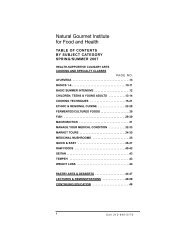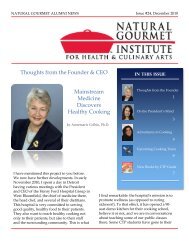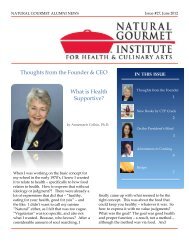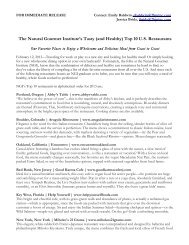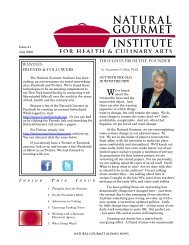Dec '11 (PDF) - The Natural Gourmet Institute
Dec '11 (PDF) - The Natural Gourmet Institute
Dec '11 (PDF) - The Natural Gourmet Institute
You also want an ePaper? Increase the reach of your titles
YUMPU automatically turns print PDFs into web optimized ePapers that Google loves.
NATURAL GOURMET ALUMNI NEWS<br />
Thoughts from the Founder & CEO<br />
To Vegan or Not<br />
to Vegan<br />
by Annemarie Colbin, Ph.D.<br />
When I started the NG in 1977, my intention<br />
was to share everything I learned or would<br />
learn about how food affects health. I started<br />
by teaching how to put vegetarian (or vegan,<br />
as I used no dairy) meals together, because<br />
people who were interested in cutting out<br />
meat were sort of using the family meal minus<br />
the meat as a base – vegetables, salad, dessert.<br />
I designed nutritionally balanced meals based<br />
on grains and beans, plus vegetables, salad,<br />
and dessert with no sugar (only natural<br />
sweeteners). I felt the vegetarians had been<br />
Issue #26, <strong>Dec</strong>ember 2011<br />
In this Issue<br />
Thoughts from the Founder<br />
New Books by CTP Grads<br />
On the President’s Mind<br />
Adventures in Cooking<br />
Recipe<br />
disrespected and ignored, and felt they<br />
deserved a seat at the table, so to speak. My<br />
vision was that restaurants would ALSO have<br />
meals for vegetarians.<br />
Thirty-five years later, this has come about,<br />
and I can’t take the credit. <strong>The</strong> time has come.<br />
And what I have noticed over the years, as<br />
1<br />
2<br />
3<br />
5<br />
7
NATURAL GOURMET ALUMNI NEWS Issue #26, <strong>Dec</strong>ember 2011<br />
vegetarian/vegan eating has become trendy,<br />
is that interesting attitudes have crept into the<br />
mix.<br />
In the early days, people chose alternative<br />
diets mostly for health reasons. Nowadays<br />
some people choose their diet for moral,<br />
ecological, and spiritual reasons. Particularly,<br />
they choose to go vegan because they don’t<br />
want to kill animals, or think it’s more<br />
spiritually evolved to eat only plants, and they<br />
want to do good and be “good people” by<br />
their food choices. This would be a laudable<br />
position, and not be a problem except for one<br />
small, unintended effect: there are some who<br />
choose this route and then pass harsh<br />
judgment on those who don’t. <strong>The</strong>y end up<br />
with an attitude of “I’m a vegan, and you’re<br />
an un-evolved caveman who kills and eats<br />
animals; therefore I’m better than you. You<br />
slob!” And they can get really nasty about it.<br />
Some of us at the NGI have been on the<br />
receiving end of that nastiness.<br />
This is counter-productive. Vegan eating is<br />
supposed to be peaceful, loving, evolved, and<br />
indicative of higher consciousness. Many<br />
times, however, it is also spiritually arrogant<br />
and disdainful of those who choose to eat<br />
differently. “By their fruits ye shall know<br />
them” – by our actions, our spirituality and<br />
moral fiber are shown. If we are loving<br />
towards animals, it makes no sense to be<br />
unloving towards people, regardless of their<br />
actions.<br />
<strong>The</strong> idea that meat eating denotes cruelty is<br />
misplaced. <strong>The</strong> universe is set up so that one<br />
creature feeds another, all around the life<br />
cycle. This is inevitable, and ecologically sane<br />
– another word for it is “recycling.”<br />
Eating kills – it kills plants no less than<br />
animals. See this New York Times article about<br />
the responses of plants towards those who<br />
would eat them! http://nyti.ms/shsSSV<br />
Humans can live by eating both plants and<br />
animals – that’s how we are designed. Some<br />
humans actually are healthier if they eat<br />
animal food. Some humans are healthier if<br />
they eat just plant foods. Either way is valid,<br />
because the point here is to live, and to be<br />
healthy so as to be able to contribute positive<br />
energy to the world. That’s why in the<br />
<strong>Natural</strong> <strong>Gourmet</strong> we teach “health-supportive<br />
cooking.” That means, whatever food<br />
supports your health is what we promote.<br />
So let’s be careful with making moral<br />
judgments about what others eat. It’s not our<br />
business. If we are to be healthy and happy,<br />
let’s support others in their road there,<br />
whatever it takes. After all, there are a lot of<br />
kind and loving people who eat burgers and<br />
fries – and there are some who eat really well<br />
and are unpleasant and angry. When<br />
considering the value of eating systems, let’s<br />
factor in compassion and kindness towards<br />
anyone’s life path. Even for those with whom<br />
we disagree.<br />
New Books by CTP Grads<br />
Spork-Fed<br />
by Jenny Engel<br />
CTP 123<br />
and her sister,<br />
Heather Goldberg<br />
<strong>The</strong> Inspired Vegan<br />
by Bryant Terry<br />
CTP 87E<br />
2
NATURAL GOURMET ALUMNI NEWS Issue #26, <strong>Dec</strong>ember 2011<br />
Most people are impressed, or at least<br />
comforted by the knowledge that the school<br />
they are attending is accredited. For some, it<br />
is a requirement. Being accredited somehow<br />
enhances the credibility and stature of<br />
institutions, yet I suspect that very few<br />
individuals are familiar with what it actually<br />
entails. Under my direction, the <strong>Natural</strong><br />
<strong>Gourmet</strong> <strong>Institute</strong> for Health & Culinary Arts<br />
first became accredited in 2000. Prior to this<br />
time, I had very little idea of what it takes to<br />
achieve this title. Over the years, we have<br />
undertaken the process of re-accreditation,<br />
which is necessary every three to five years,<br />
depending on the term your accrediting<br />
agency confers upon your institution. I am<br />
very happy to report that we recently received<br />
the maximum five-year term from ACCET<br />
(Accrediting Council for Continuing<br />
Education & Training).<br />
On the President’s Mind<br />
Accreditation Update<br />
by Jenny Matthau<br />
<strong>The</strong> first step to becoming accredited or<br />
reaccredited is attending a two-day<br />
reaccreditation seminar in Washington D.C.<br />
In the past, Merle Brown and I have done this,<br />
but last year Jeri Rostron took my place. I<br />
have fond memories of dining at Restaurant<br />
Nora and taking a night tour of the<br />
presidential monuments. I highly recommend<br />
these activities to anyone visiting for the first<br />
time.<br />
<strong>The</strong> second step is completing an Analytic Self<br />
Evaluation Report (ASER), consisting of eight<br />
standards: Mission, Management, Financial<br />
Practices, Curricula, Instructional Delivery,<br />
Instructional Personnel, Admissions and<br />
Student Services, and Evaluation. Each<br />
standard consists of subsections, and there are<br />
several questions in each of these to be<br />
answered.<br />
3
NATURAL GOURMET ALUMNI NEWS Issue #26, <strong>Dec</strong>ember 2011<br />
<strong>The</strong> “Mission” section is subdivided into<br />
Mission Statement, Goals, and Planning. It<br />
includes questions about the relevance,<br />
conveyance and success of the institution’s<br />
mission, including short-term and long-term<br />
plans.<br />
<strong>The</strong> “Management” section is subdivided into<br />
Governance, Operational Management,<br />
Personnel Management, Records,<br />
Communications, and Professional<br />
Relationships. This section focuses on<br />
ownership, organizational charts, legal<br />
entities, job descriptions of key positions and<br />
various governing boards and organizational<br />
associations.<br />
<strong>The</strong> “Financial Practices” section is subdivided<br />
into Stability, Financial Procedures<br />
and Financial Assistance/Scholarships. <strong>The</strong><br />
purpose of this section is to determine if the<br />
institution is fiscally sound, uses policies and<br />
procedures that ensure accurate monitoring of<br />
all financial transactions, and operates in a<br />
manner that guarantees fair and ethical<br />
treatment of all students.<br />
<strong>The</strong> “Curricula” section is subdivided into<br />
Educational Goals and Curricular Objectives,<br />
Program/Instructional Materials, Performance<br />
Measurements, Curriculum Review/Revision,<br />
and Certification and Licensing. It is designed<br />
to ascertain whether the institution’s<br />
curricular design, materials and outcomes<br />
measurements follow sound educational<br />
practices. This includes lesson plans, books,<br />
handouts, grading methodology, quizzes and<br />
exams.<br />
<strong>The</strong> “Instructional Delivery” section is subdivided<br />
into Instructional Methods,<br />
Externships/Internships, Equipment/Supplies,<br />
and Facilities. It focuses on the various<br />
ways in which students learn and are<br />
motivated, methods and materials used by the<br />
instructional staff and a detailed description of<br />
the physical premises, including layout and<br />
equipment.<br />
<strong>The</strong> “Instructional Personnel” section is<br />
subdivided into Qualifications of Instructional<br />
Personnel, Supervision of Instruction, and<br />
Instructor Orientation and Training. This<br />
section is designed to ascertain whether<br />
instructors are qualified and receive the<br />
direction and supervision required to<br />
effectively deliver educational and training<br />
objectives.<br />
<strong>The</strong> “Admissions and Student Services”<br />
section is subdivided into Recruitment,<br />
Enrollment, Transfer of Credit, and Student<br />
Services. It is designed to determine if the<br />
institution recruits and enrolls only qualified<br />
students who can reasonably be expected to<br />
benefit from the education and training<br />
services and provides student services<br />
appropriate to their needs.<br />
<strong>The</strong> “Evaluation” section is subdivided into<br />
Student Progress, Attendance, Participant<br />
Satisfaction, Employer/Sponsor Satisfaction,<br />
and Completion and Placement. This section<br />
includes questions regarding whether the<br />
institution utilizes appropriate methods of<br />
evaluation to ensure that outcomes are<br />
consistent with the mission and goals of the<br />
institution.<br />
We answered 163 questions in total (yes, I<br />
counted!), some requiring a brief answer and<br />
others requiring several pages. An equally<br />
important part of the ASER is providing<br />
documentation for all of the submitted<br />
answers in the form of exhibits. For example,<br />
it is not sufficient to state that you conduct<br />
Board Meetings every three weeks. You must<br />
provide minutes of the meetings to prove that<br />
you do this. We compiled over 100 exhibits<br />
for our report. <strong>The</strong>re must be written policies<br />
and procedures for virtually every job and<br />
every conceivable action/expectation<br />
pertaining to staff, students and graduates.<br />
4
NATURAL GOURMET ALUMNI NEWS Issue #26, <strong>Dec</strong>ember 2011<br />
After the ASER is submitted, a three-person<br />
team consisting of a management specialist,<br />
an education specialist and a representative<br />
from ACCET visit the applicant institution for<br />
two full days. During this time, they conduct<br />
in-depth interviews with office staff,<br />
instructors and students in order to verify the<br />
accuracy of the ASER. <strong>The</strong> team also writes a<br />
report, citing both strengths and weaknesses<br />
of the school. <strong>The</strong> institution then writes a<br />
response, addressing all the cited weaknesses<br />
and offering solutions (usually as written<br />
policies/procedures).<br />
<strong>The</strong> Accrediting Commission then votes to<br />
either deny reaccreditation or to continue<br />
Post radiation, not only was Amelia more<br />
medically stable but Ralphie, with help from<br />
Amelia’s mom, somehow found the time,<br />
strength and energy to author Ralphie’s<br />
Radiation Rescue, a book full of “helpful hints”<br />
for coping with new and sometimes<br />
frightening situations.<br />
This book includes powerful day-by-day<br />
photos of Amelia and her friends as she faced<br />
the first of many medical and emotional<br />
challenges.<br />
accreditation for either three or five years.<br />
Attaining the title “Accredited Institution” is a<br />
very arduous undertaking that involves the<br />
participation of the entire staff.<br />
Communication and dedication to the process<br />
are absolute prerequisites to success. Once<br />
accredited, the hard work continues, but the<br />
benefits of increased access to funding for<br />
some students and a better school and<br />
education for all our students makes it a<br />
worthwhile endeavor.<br />
I hope you are all well,<br />
Jenny<br />
Adventures in Cooking<br />
Tea Anyone?<br />
by Sue Baldassano<br />
Barely 6 years old, diagnosed with a brain tumor and recovering<br />
from brain surgery, Amelia Scheffs-Bevington instinctively knew<br />
how to best navigate those first early treatments.<br />
Facing 30 days of radiation, Amelia grabbed Ralphie (her frombirth<br />
stuffed doggie) and a couple of other stuffed doggie friends<br />
to physically “book end” her in the big, scary radiotherapy<br />
machine while she lay perfectly still for over an hour each day.<br />
For me, the most amazing photo in the book<br />
was taken the day after the treatments were<br />
completed, when back at home, Amelia hosted<br />
an impromptu tea party for all her doggie<br />
friends, who were literally at her side when<br />
she needed them most.<br />
It seems no matter who we are and what we<br />
are going through, sharing sustenance around<br />
a table with loved ones (even stuffed ones)<br />
makes everything, even brain cancer, a bit<br />
easier.<br />
5
NATURAL GOURMET ALUMNI NEWS<br />
As a long time friend of Amelia’s parents and<br />
a visitor to their home before she was ill,<br />
Amelia’s gracious hostessing for her stuffed<br />
doggie friends sparked something deep inside<br />
me. I decided then and there that I would<br />
help this family get through this ordeal by<br />
cooking for them, nurturing the family as they<br />
worked valiantly to care for Amelia.<br />
Once a week, after work, for 4 years and 9<br />
months I trekked up to their 4 th floor walk-up<br />
in Long Island City and cooked dinner for<br />
them.<br />
I was often assisted by volunteer chefs, mostly<br />
students, who wanted some private cooking<br />
experience and more<br />
importantly, wanted to help a<br />
family in need.<br />
Not only did we cook for the<br />
family, we sometimes cooked<br />
with Amelia. When she was<br />
feeling well enough we made<br />
healthier cookies in the shape<br />
of animals (dolphins and<br />
turtles were especially popular<br />
motifs). Whole wheat pizza<br />
and bread were also<br />
attempted, one of our goals<br />
being to keep Amelia engaged<br />
in life and interested in eating.<br />
Healthy, homemade meals,<br />
often inspired by graduate Rebecca Katz’s<br />
book, <strong>The</strong> Cancer Fighting Kitchen, were piping<br />
hot and ready when Amelia’s family arrived<br />
home -- Amelia and Mommy Kate often<br />
arriving after a grueling day of needles,<br />
uncomfortable/painful tests or just waiting<br />
around endlessly for results at the hospital;<br />
Mama Margaret and brother Leon, both tired<br />
and worried, returning from work and school<br />
respectively.<br />
Amelia was often not hungry but when she<br />
was, she was well fed. Some of her favorite<br />
Issue #26, <strong>Dec</strong>ember 2011<br />
meals included salmon with capers, beef stew,<br />
quinoa pilaf, roasted corn, fresh pineapples,<br />
guacamole (sans the jalapeno) and mashed<br />
sweet potatoes. <strong>The</strong> last meal she ate on this<br />
earth was a quinoa and corn tabouli salad that<br />
I prepared.<br />
After her first recurrence, almost 2 years after<br />
diagnosis, the family began working with Jean<br />
Wallace, a nutritionist specializing in brain<br />
cancer. She was recommended by NGI<br />
graduate Laura Pole, an oncology nurse and<br />
cooking instructor who does a million great<br />
things including cancer workshops at Smith<br />
Farm Retreats.<br />
Along with her vast knowledge<br />
of cancer, Laura uses food, song<br />
(she’s a musician) and a sheer<br />
lust for life to help people with<br />
cancer heal. She visited Amelia<br />
twice and offered a free<br />
consultation to the family.<br />
During this process Amelia’s<br />
Mama Margaret started getting<br />
interested in healthy cooking,<br />
and through an anonymous<br />
donor, she was able to attend<br />
classes at the NGI including<br />
Laura Pole’s Cooking for People<br />
with Cancer class. She also took a<br />
Knife Skills class and Indian<br />
cooking class with Chef Rich<br />
LaMarita and a Basics and Inflammation class<br />
with Chef Jill Gusman. Amelia’s brother,<br />
Leon, adores Jill’s parsley garlic sauce. I make<br />
it for him every time I cook.<br />
Shortly after Amelia’s cancer recurred, <strong>The</strong><br />
Amelia Appeal Foundation was created as a<br />
way to assist the family with the astronomical<br />
monetary costs of treatment. Even with good<br />
insurance there are tons of co-pays, and<br />
alternative or complementary treatment is not<br />
covered at all.<br />
Somehow I ended up being the President of<br />
6
NATURAL GOURMET ALUMNI NEWS Issue #26, <strong>Dec</strong>ember 2011<br />
this foundation, and in 2010, we orchestrated<br />
our first, and to date, only fundraiser. Again,<br />
volunteer chefs (mostly students from the<br />
NGI) materialized to help prepare healthy<br />
hors d’oeuvres for 200. <strong>The</strong>se students<br />
received no internship or stewarding hours<br />
and no money. <strong>The</strong>y just did it for the<br />
experience and to help Amelia. Not only were<br />
students involved but many cookbook authors<br />
donated books for a raffle.<br />
Today, <strong>The</strong> Amelia Appeal is focusing on<br />
pediatric cancer awareness. We hope to selfpublish<br />
Ralphie’s Radiation Rescue and help<br />
other families with funds and food while they<br />
are dealing with such a devastating<br />
experience.<br />
After her diagnosis, Amelia visited Florida on<br />
three occasions. In late February of 2011,<br />
Amelia wanted to visit Florida again. She was<br />
in a wheelchair, too weak to walk, pumped<br />
full of steroids and not feeling well at all, yet<br />
Amelia had the will to visit Florida, and she<br />
and Mommy Kate visited on March 5 th (2<br />
months to the day before she passed away).<br />
<strong>The</strong> foodie in Amelia really manifested on<br />
these trips. Viewing sea creatures, especially<br />
manatees, might have been number one on<br />
her list of things to visit in Florida, but the<br />
menu selections were definitely a close<br />
second. When in Florida, Amelia enjoyed<br />
shrimp, shrimp and more shrimp!<br />
During the nearly 5 years Amelia was ill she<br />
enjoyed birthday parties, Christmas,<br />
Halloween parties and many “just plain<br />
dinner parties.” Once again, student chefs<br />
often volunteered to cook homemade desserts<br />
without white sugar, healthy salads, whole<br />
grains and good quality proteins.<br />
I was present when Amelia passed away.<br />
High up in a sun-filled room overlooking the<br />
East River and the magnificent cityscape,<br />
Amelia was surrounded by her loving parents,<br />
her best friend Dee, Jessica, the life specialist<br />
at Sloan Kettering, and of course, Ralphie. As<br />
her parents held her close, Jessica reminded<br />
her she would soon be swimming with the<br />
manatees, the animals she so loved and visited<br />
often in Florida. At exactly 12 noon, Amelia<br />
closed her eyes and drifted from us peacefully.<br />
Standing at the foot of her bed, I made a silent<br />
promise to Amelia: to continue cooking for her<br />
brother and her parents as they begin their<br />
long slow process of healing.<br />
Best,<br />
Sue<br />
Quinoa and Roasted Corn Tabouli<br />
Yield: approx. 2 cups<br />
1 cup quinoa, rinsed<br />
1 tablespoon extra virgin olive oil<br />
¼ teaspoon sea salt<br />
1 ¼ cup boiling stock<br />
2 ears corn, roasted and kernels removed from cob<br />
1-2 cloves garlic, minced<br />
2 tablespoons chopped mint<br />
2 tablespoons chopped parsley<br />
3-4 tablespoons lime juice<br />
Procedure:<br />
Heat oven to 350 degrees. Place rinsed quinoa in a<br />
small loaf pan with the oil and salt. Bake in oven<br />
until quinoa begins to dry. Add boiling stock.<br />
Cover pan with tin foil and bake until quinoa is<br />
fluffy and all stock has been absorbed (about 20<br />
minutes).<br />
Remove quinoa from pan and place in a medium<br />
bowl. Allow to cool.<br />
Add remaining ingredients. Season to taste and<br />
serve.<br />
© <strong>Dec</strong>ember 2011 <strong>Natural</strong> <strong>Gourmet</strong> <strong>Institute</strong><br />
for Health & Culinary Arts<br />
Editor: Rosemary Serviss<br />
7





